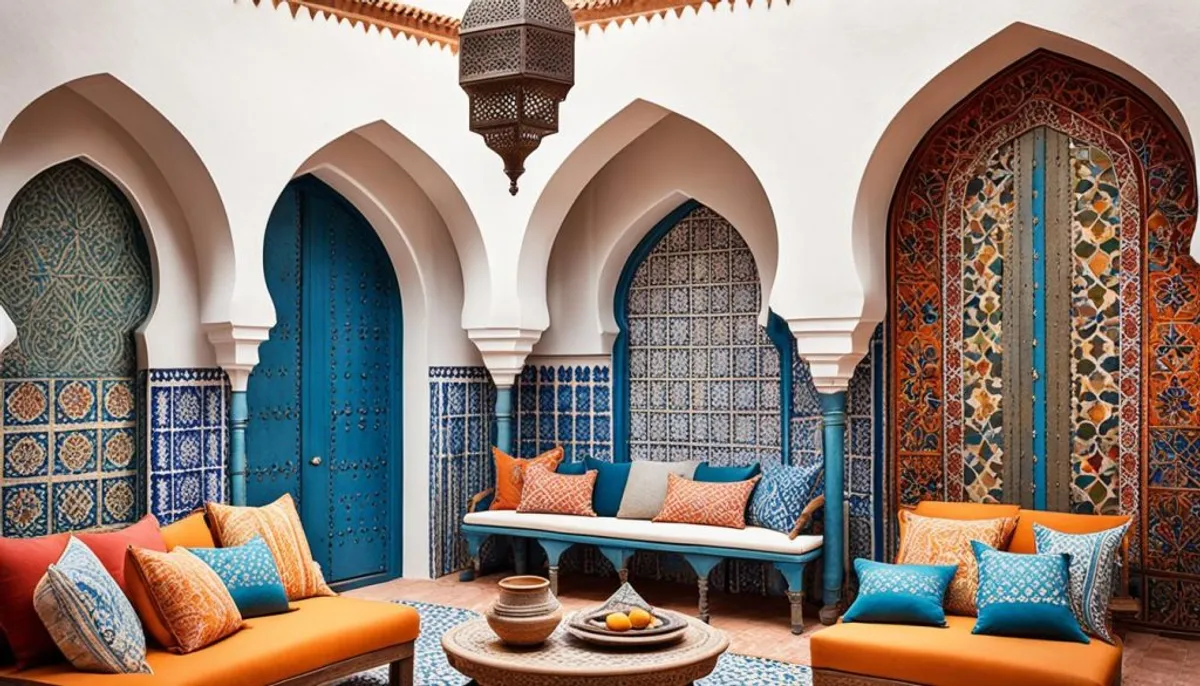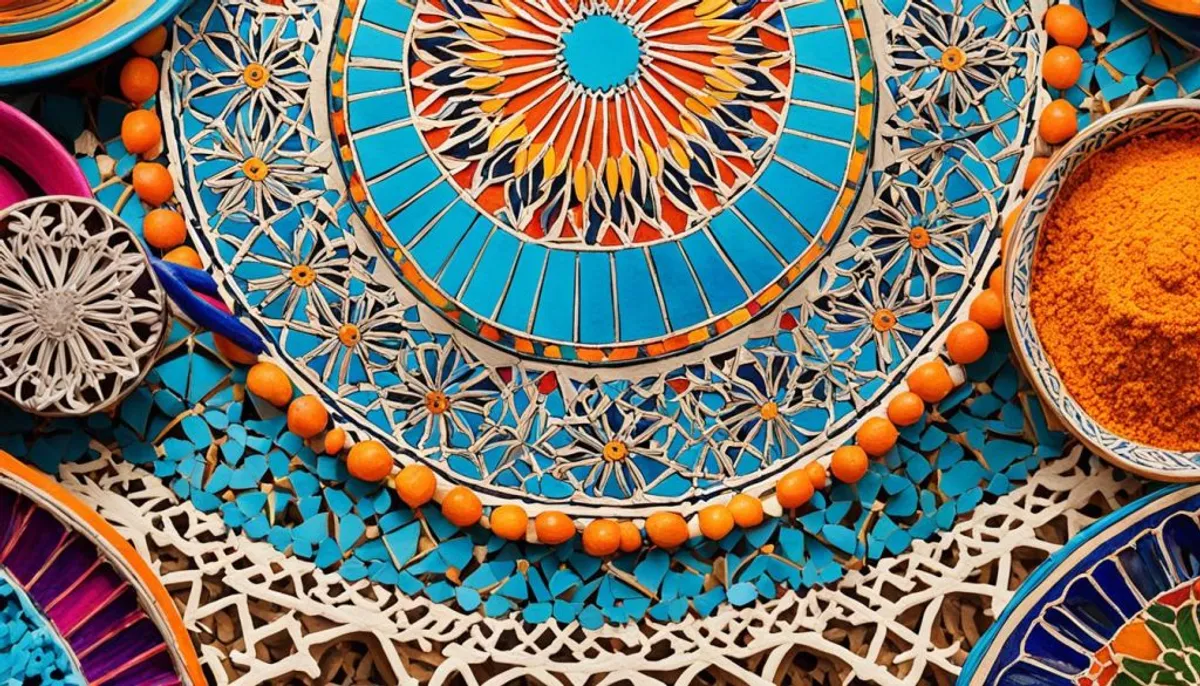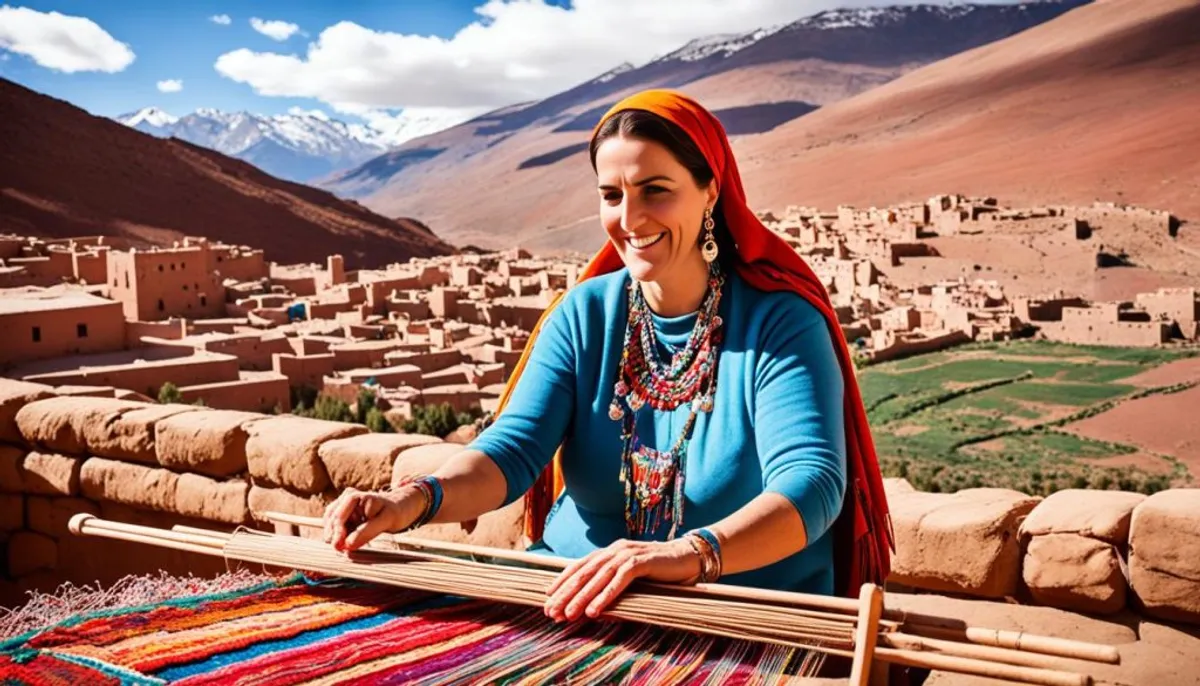Morocco is located at the intersection of Africa, Europe, and the Middle East. This unique geographical position has shaped its culture. It has influenced its art, ranging from architecture to pottery, including weaving and the creation of jewelry.
The Moroccan culture is rich and varied. It combines centuries-old traditions and creative innovations. This creates a unique cultural landscape.

Overview of Moroccan Culture
Morocco is a country rich in cultures, situated between Africa, Europe, and the Middle East. This cultural diversity creates a cultural heritage that is unique. It is the result of a harmonious blend of Arab, Berber, and African influences.
Diverse Cultural Influences
The Moroccan culture was born from the exchange between different civilizations. Arab, Berber, and African traditions have merged. They have created a unique and captivating cultural identity.
Mosaic of Arab, Berber, and African Traditions
From this mosaic of traditions has emerged a cultural richness. It is visible in architecture, crafts, gastronomy, music, and customs. Arab culture, Berber culture, and African culture complement each other. They give Moroccan culture its distinctiveness.
| Cultural Influences | Traditions and Heritage |
|---|---|
| Arab | Architecture, crafts, gastronomy |
| Berber | Music, folk dances |
| African | Customs, lifestyle |
Traditions and Cultural Heritage
Morocco is known for its Moroccan craftsmanship, a testament to its ancestral know-how. In the souks, one finds numerous products created by local artisans. Among them are rugs, baskets, pottery, jewelry, goldsmithing, and traditional clothing such as the burnous and djellaba. These objects showcase the diversity and depth of Moroccan culture.
Languages and Ethnicities
Morocco is rich in linguistic diversity, with Moroccan Arabic and Berber languages as the main languages. This linguistic plurality reflects the country's ethnic mosaic. Groups such as Arabs, Berbers, and Moroccan Jews contribute to this cultural richness.
National Symbols
The national symbols of Morocco include the royal coat of arms, the national anthem, and the animal emblem, the Atlas lion. These symbols represent the identity and cultural heritage of Morocco. They reflect the pride and unity of the nation.

Religious Practices and Beliefs
Morocco is a country rich in religious diversity. Islam is the majority religion, with over 95% of the population. However, there are also Jews and Christians, showcasing the cultural richness of the country.
Islam in Morocco
Islam is very important to Moroccans. Mosques and zaouias are at the heart of spiritual and social life. They serve as places of prayer, teaching, and gathering.
Judaism and Christianity
Jews and Christians, although minorities, have influenced Morocco's religious identity. Figures like Marcel the Centurion and Albert Peyriguère have marked Moroccan Christian history. This coexistence demonstrates Morocco's tolerance and open-mindedness.
The religious diversity is essential to the cultural heritage of Morocco. This richness and tolerance make Morocco a unique place of welcome and exchange.
Traditional Cultures and Daily Life
The Berber culture is very important in Morocco. The Amazigh traditions, customs, the Berber calendar, and Berber beliefs have forged Moroccan identity. These ancient traditions still influence the lives of Moroccans.
Moroccan Gastronomy
Moroccan gastronomy is rich and varied. It is based on family and community traditions. Dishes such as tajine, couscous, and delicious pastries can be found. Traditional beverages like mint tea or fermented milk offer a sensory journey.
Music and Folk Dances
Morocco is rich in musical traditions and folk dances. These traditions are tied to the culture and history of the country. Gnaoua, fantasia, chirra, and al hite are examples of Moroccan music. This music is a living heritage, showcasing the richness and creativity of Morocco.
| Traditional Dish | Description |
|---|---|
| Tajine | Stew with an iconic design and serving style, made with meat, vegetables, and spices. |
| Couscous | Culinary specialty made from wheat semolina, served with sauce and vegetables or meat. |
| Pastries | Delicious Moroccan pastries such as mhalbiya, sellou, or chebakia. |

Arts and Moroccan Culture
Morocco is rich in culture, visible in its architecture, craftsmanship, and literature. These arts showcase the diversity of influences that have shaped Moroccan identity.
Architecture and Craftsmanship
The Moroccan architecture is known for its beauty and authenticity. Zellige, these terracotta tile mosaics, adorn many buildings. Gypsum work and Berber jewelry showcase the richness of Moroccan craftsmanship. Calligraphy, the art of writing, is also very present in Morocco.
Moroccan Literature
Moroccan literature is varied, in Arabic, Berber, or French. It reflects the cultural diversity of the country. Folktales, contemporary novels, and Amazigh poetry are a rich heritage.
Cultural Festivals
Morocco celebrates its culture throughout the year with numerous festivals and traditional celebrations. The Rose Festival, the Fantasia of Meknes, the Mawazine Festival, and the Gnaoua festivals of Essaouira highlight its traditions.
Conclusion
The Moroccan culture is a blend of ancient traditions. It reflects the history and geographical situation of the country. Craftsmanship, cuisine, literature, and the arts showcase the diversity of Morocco.
Morocco takes pride in its rich and vibrant culture. It aims to preserve its traditions and pass them on to the future. Moroccan culture is a heritage to protect and share.
From the coast to the Atlas, Morocco is rich in traditions. It is a treasure of history and creativity. Discover Moroccan culture and let yourself be inspired by its richness.
RelatedRelated articles


